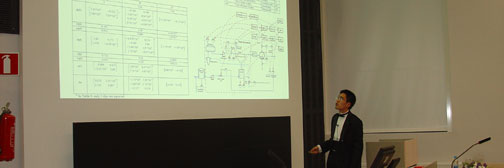| | Year 2014
Aleksi Petteri EskelinenDynamic modelling of a multiple hearth furnace
The aim of this thesis is to develop a dynamic model of a multiple hearth furnace (MHF) used for the kaolin calcination process. The resulting model facilitates in studying the complex physico-chemical phenomena occurring inside the furnace and providing a dynamic simulator for monitoring purposes. The dynamic model also provides means to develop a better control over the temperature profile of the kaolin bed moving inside the furnace. In addition, it is of utmost importance to run the process with minimum energy losses together with minimum possible emissions.
The literature part first introduces a common kaolin wet processing production chain after which the kaolin calcination process is studied in detail. Next, calcination reactions and the effects of factors, such as heating rate, particle size and impurities in the raw material to the calcination reactions are studied. Additionally, five different mathematical models similar to the kaolin calciner (MHF) are reviewed to understand the restrictions and the requirements for the development of a dynamic model of the MHF.
Particularly, the dynamic model of the MHF is developed in the experimental part. First, the modelling equations for the reaction kinetics, mass and heat transfer and conservation, including the heat exchange parameters, are described. Subsequently, experimental test are performed on a 1:12 scaled pilot model of the industrial furnace that determines the solid bed dynamics matrix. This matrix describes the solid bed movement and mass distribution in the furnace. To solve the system of the model equations the mathematical solving algorithms are introduced; the reaction rates are solved explicitly, the solid bed mass transfer is calculated using the developed mixing model, the mass and energy balances of the gas phase are solved with the internal division method, the temperature profiles of the cooling air, the central shaft and the arms and the walls are computed using the Euler method combined with internal division method and the solid bed energy balance is solved combining the Euler method with the mixing model. The MHF model is implemented under the MATLAB environment. In addition, a graphical user interface is developed for the MHF simulator.
The dynamic behaviour of the model is tested using step changes in the three inputs, namely the feed rate, the gas and air flows to the hearth 4 and the gas and air flows to the hearth 6, individually. In addition, the behaviour under simultaneous changes in each input variables is studied and finally the dynamics of the simulated model are tested and validated using the real industrial data.
The results show that the response of the model to the aforesaid changes is reasonable. It is also noticed that the response of the gas phase temperature is almost immediate and the response time of the changes in the solid bed composition is even over 700 minutes in some cases. Comparing the simulated results obtained from the dynamic model to that of the industrial data, the model behaves satisfactorily and the simulated temperature profile matches to the measured temperatures.
Thesis electronical version can be downloaded from here
Thesis electronical version can be downloaded from here
This info last modified 27 Apr 2024 by Jukka Kortela
|

